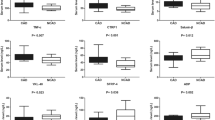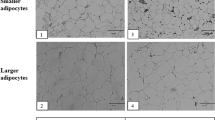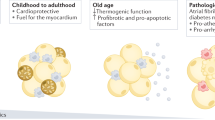Abstract
Objective:
Epicardial and abdominal adipose tissues have recently been demonstrated to play inflammatory roles in coronary atherosclerosis. We sought to compare tissue adipocytokine levels of these two anatomically distinct adipose stores in patients with and without coronary artery diseases (CAD).
Design:
Samples of abdominal and epicardial fat tissues were harvested to detect the levels of adipocytokines and proinflammatory mediators.
Subjects:
Forty-six patients with CAD who underwent coronary artery bypass surgery and 12 non-CAD control subjects who underwent other types of open-heart surgery.
Measurements:
Tissue levels of adipocytokines (adiponectin, leptin and visfatin) and proinflammatory mediators (tumor necrosis factor-α (TNF-α) and interleukin-6 (IL-6)) were determined by enzyme-linked immunosorbent assay.
Results:
Tissue levels of TNF-α, IL-6, leptin and visfatin were significantly higher in CAD patients relative to control subjects. In addition, significantly higher tissue levels of these four cytokines from abdominal fat depots were found compared to those from epicardial fat in CAD patients. Conversely, in comparison with control subjects, tissue levels of adiponectin were significantly reduced in CAD patients with a significantly lower tissue levels of abdominal than epicardial fat depots demonstrated.
Conclusion:
Abdominal adiposity may play more significant role than epicardial fat in the pathogenesis of coronary atherosclerosis.
This is a preview of subscription content, access via your institution
Access options
Subscribe to this journal
Receive 12 print issues and online access
$259.00 per year
only $21.58 per issue
Buy this article
- Purchase on Springer Link
- Instant access to full article PDF
Prices may be subject to local taxes which are calculated during checkout

Similar content being viewed by others
References
Carr MC, Brunzell JD . Abdominal obesity and dyslipidemia in the metabolic syndrome: importance of type 2 diabetes and familial combined hyperlipidemia in coronary artery disease risk. J Clin Endocrinol Metab 2004; 89: 2601–2607.
Lebovitz HE . The relationship of obesity to the metabolic syndrome. Int J Clin Pract 2003; Suppl(134): 18–27.
Kershaw EE, Flier J . Adipose tissue as an endocrine organ. J Clin Endocrinol Metab 2004; 89: 2548–2556.
Lau DC, Dhillon B, Yan H, Szmitko PE, Verma S . Adipokines: molecular links between obesity and atheroslcerosis. Am J Physiol Heart Circ Physiol 2005; 288: H2031–H2041.
Rajala MW, Scherer P . Minireview: The adipocyte—at the crossroads of energy homeostasis, inflammation, and atherosclerosis. Endocrinology 2003; 144: 3765–3773.
Wajchenberg BL . Subcutaneous and visceral adipose tissue: their relation to the metabolic syndrome. Endocr Rev 21: 697–738.
Fain JN, Madan AK, Hiler ML, Cheema P, Bahouth SW . Comparison of the release of adipokines by adipose tissue, adipose tissue matrix, and adipocytes from visceral and subcutaneous abdominal adipose tissues of obese humans. Endocrinology 2004; 145: 2273–2282.
Fisher FM, McTernan PG, Valsamakis G, Chetty R, Harte AL, Anwar AJ et al. Differences in adiponectin protein expression: effect of fat depots and type 2 diabetic status. Horm Metab Res 2002; 34: 650–654.
Mazurek T, Zhang L, Zalewski A, Mannion JD, Diehl JT, Arafat H et al. Human epicardial adipose tissue is a source of inflammatory mediators. Circulation 2003; 108: 2460–2466.
Baker AR, Silva NF, Quinn DW, Harte AL, Pagano D, Bonser RS et al. Human epicardial adipose tissue expresses a pathogenic profile of adipocytokines in patients with cardiovascular disease. Cardiovasc Diabetol 2006; 5: 1–7.
Iacobellis G, Pistilli D, Gucciardo M, Leonetti F, Miraldi F, Brancaccio G et al. Adiponectin expression in human epicardial adipose tissue in vivo is lower in patients with coronary artery disease. Cytokine 2005; 29: 251–255.
Iacobellis G, Corradi D, Sharma AM . Epicardial adipose tissue: anatomic, biomolecular and clinical relationships with the heart. Nat Clin Pract Cardiovasc Med 2005; 2: 536–543.
Iacobellis G, Ribaudo M, Assael F, Vecci E, Tiberti C, Zappaterreno A et al. Echocardiographic epicardial adipose tissue is related to anthropometric and clinical parameters of metabolic syndrome: a new indicator of cardiovascular risk. J Clin Endocrinol Metab 2003; 88: 5163–5168.
Iacobellis G, Assael F, Ribaudo MC, Zappaterreno A, Alessi G, Di Mario U et al. Epicardial fat from echocardiography: a new method for visceral adipose tissue prediction. Obes Res 2003; 11: 304–310.
Curat CA, Wegner V, Sengenes C, Miranville A, Tonus C, Busse R et al. Macrophages in human visceral adipose tissue: increased accumulation in obesity and a source of resistin and visfatin. Diabetologia 2006; 49: 744–747.
Trujillo ME, Sullivan S, Harten I, Schneider SH, Greenberg AS, Fried SK . Interleukin-6 regulates human adipose tissue lipid metabolism and leptin production in vitro. J Clin Endocrinol Metab 2004; 89: 5577–5582.
Ouchi N, Kihara S, Arita Y, Okamoto Y, Maeda K, Kuriyama H et al. Adiponectin, an adipocyte-derived plasma protein, inhibits endothelial NF-kappaB signaling through a cAMP-dependent pathway. Circulation 2000; 102: 1296–1301.
Ouchi N, Kihara S, Arita Y, Maeda K, Kuriyama H, Okamoto Y et al. Novel modulator for endothelial adhesion molecules: adipocyte-derived plasma protein adiponectin. Circulation 1999; 100: 2473–2476.
Pilz S, Maerz W, Weihrauch G, Sargsyan K, Almer G, Nauck M et al. Adiponectin serum concentrations in men with coronary artery disease: the LUdwigshafjen RIsk and Cardiovascular Health (LURIC) study. Clin Chim Acta 2006; 364: 251–255.
Pischon T, Girman CJ, Hotamisligil GS, Rifai N, Hu FB, Rimm EB . Plasma adiponectin levels and risk of myocardial infarction in men. JAMA 2004; 291: 1730–1737.
Fukuhara A, Matsuda M, Nishizawa M, Segawa K, Tanaka M, Kishimoto K et al. Visfatin: a protein secreted by visceral fat that mimics the effects of insulin. Science 2005; 307: 426–430.
Jeong JW, Jeong MH, Yun KH, Oh SK, Park EM, Kim YK et al. Echocardiographic epicardial fat thickness and coronary artery disease. Circ J 2007; 71: 536–539.
Sacks HS, Fain JN . Human epicardial adipose tissue: a review. Am Heart J 2007; 153: 907–917.
Rabkin SW . Epicardial fat: properties, function and relationship to obesity. Obes Rev 2007; 8: 253–261.
Acknowledgements
We thank Li-Fong Jo, Hwei-Fong Chen and Shou-Yun Lu for their technical assistance and data collection, and Yi-Hsien Yang for the statistical analysis.
Author information
Authors and Affiliations
Corresponding author
Rights and permissions
About this article
Cite this article
Cheng, KH., Chu, CS., Lee, KT. et al. Adipocytokines and proinflammatory mediators from abdominal and epicardial adipose tissue in patients with coronary artery disease. Int J Obes 32, 268–274 (2008). https://doi.org/10.1038/sj.ijo.0803726
Received:
Revised:
Accepted:
Published:
Issue Date:
DOI: https://doi.org/10.1038/sj.ijo.0803726
Keywords
This article is cited by
-
Epicardial adipose tissue in contemporary cardiology
Nature Reviews Cardiology (2022)
-
Association of Epicardial Fat with Diastolic and Vascular Functions in Children with Type 1 Diabetes
Pediatric Cardiology (2022)
-
Development of artificial intelligence in epicardial and pericoronary adipose tissue imaging: a systematic review
European Journal of Hybrid Imaging (2021)
-
The role of ectopic adipose tissue: benefit or deleterious overflow?
European Journal of Clinical Nutrition (2021)
-
Association between body fat parameters and arterial stiffness
Scientific Reports (2021)



